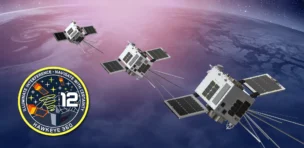Astra, the California rocketmaker that endured a tumultuous financial journey from private to public and back again, has snagged another chance to compete in orbital transportation.
Astra announced a contract last week worth as much as $44M from the DIU’s Novel Responsive Space Delivery program, with an initial payment of $2M. After Virgin Orbit’s bankruptcy in 2023, Astra is alone in developing a mobile satellite ground launch system.
Astra is raising a $50M capital round to support the development of its launch vehicle, dubbed Rocket Four, CEO Chris Kemp told Payload.
“That is all the capital we need to not only return to the pad and start flying again, but have a very profitable company with positive free cash flow,” Kemp said. “In a way, the only space companies in America that matter are SpaceX and Rocket Lab. So, we’d like to be number three.”
Playing percentages: Astra emerged from stealth in 2020 with plans for an ultra-cheap, launch site agnostic rocket, and went public at a $2.1B valuation in 2021 during the space SPAC boom.
But two failures in their first four commercial launches just as the stock market soured on risky frontier tech left the company’s future in doubt.
Kemp and his cofounder, CFO Adam London, raised $65M to take the company private in a $11.25M transaction that closed this spring. That forced the company to scale down, to 125 employees from a peak of 359 in 2022, and to rethink its approach.
“I think the philosophy did change,” Kemp said. “If you were to ask me three or four years ago, I would have said, ‘You know what? It’s about price, and the satellites are disposable. The rockets are disposable. Who cares? You know, if we get 90% reliability, everybody will be happy.’ I was wrong about that…We realized that in order to have scale, you needed reliability.”
Four square: Now, Astra is pushing to get Rocket Four to the pad to fly a previously contracted mission for the Space Force; the new DIU funding will help the company get there as it unlocks funding by achieving development milestones for a test flight in 2025. Astra is working to implement the standards and documentation required to deliver a reliable launch system.
The company is manufacturing its own first-stage engine after a partnership with Firefly Aerospace to use its Reaver engines ended. The second stage will use Ursa Major’s Hadley engine.
The 600-kg payload rocket would be one of the smaller commercial rockets on the market, with a price point of $10-$12M for national security missions and $5-$6M for commercial. Kemp is betting on the military’s need for responsive launch and hypersonic testing, along with delivering commercial small sats to bespoke orbits.
“Our goal is to be very complementary to SpaceX, we’ll let Rocket Lab go directly compete with SpaceX,” Kemp said. “We’re the only ones that have a factory that can make hundreds of rockets per year.”
Lessons learned: While Astra is still benefiting from the $100M production facility built with its SPAC money, Kemp says the requirements facing public companies don’t jibe with the realities of scaling a manufacturing business.
“In my view, no manufacturing company in America should be public unless they’re doing at least a billion in revenue and have at least 30% to 40% gross margins,” he told Payload. “And so we will be private for some time.”
Reflecting on the company’s financial saga, Kemp says, “We did what we needed to do to survive—all of our customers that were meaningful, and all of our competitors, all merged with SPACs, and they all went public. And we also did what we needed to do to survive when we took the company private.”
“I wish the markets hadn’t shifted so violently, as I would prefer to have stayed a public company, frankly, and just fought our way through it,” he said. “I do think getting to a billion in revenue is achievable within a five year period, if we hadn’t gotten the legs knocked out from under us.”




